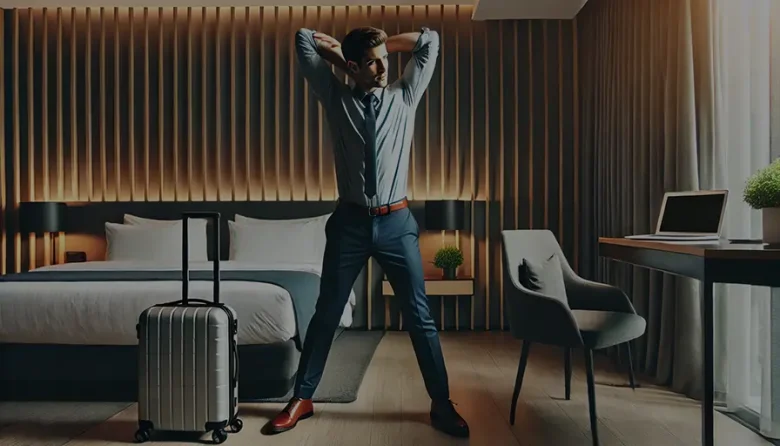Table of Contents
Among the daily challenges faced by executives who are always on the move, taking care of their physical and mental health is essential to maintaining performance and quality of life. Amid busy schedules, long flights and back-to-back meetings, many professionals end up neglecting simple practices that can prevent muscle pain and tension. This article explores, in a comprehensive and detailed way, the express physiotherapy strategies that can transform the routine of executives, relieving discomfort and promoting well-being even on business trips.
The Impact of Business Travel on Health
The routine of corporate travel poses a series of challenges to the body and mind. Constant adaptation to new environments, changing time zones and spending long periods of time in uncomfortable seats generate cumulative effects that can compromise muscular and general health.
Stress and Fatigue
Business travel often involves high levels of stress, which manifests itself not only in the mind but also in the body. The pressure to achieve results, combined with the logistics of travel, contributes to increased physical fatigue. Studies show that chronic stress can trigger muscle stiffness and worsen feelings of fatigue, negatively impacting performance. productivity and the mood.
Adaptation to Different Environments
The routine of an executive who is constantly traveling includes adapting to different hotels, meeting rooms and means of transport. Each environment has its own ergonomics, which are not always ideal for long periods of work or rest. For example, airplane seats and furniture in hotels may not provide adequate support for the spine, intensifying muscle pain and tension.
Consequences of Inadequate Posture
Sitting for long hours without taking breaks to stretch can result in poor posture, causing discomfort in the cervical region, shoulders and back. This poor posture, combined with stress, can lead to musculoskeletal problems in the medium and long term. Therefore, implementing express physiotherapy practices becomes a valuable tool to mitigate these effects.
Understanding Muscle Strains
Before delving into specific techniques, it is essential to understand what muscle tensions are and how they develop, especially in contexts of trips and intense activities.
Definition and Symptoms
Muscle strains are characterized by involuntary and prolonged contractions of the muscles, resulting in stiffness, discomfort and even pain. The most common symptoms include:
- Feeling of tightness and stiffness
- Localized pain, mainly in the cervical region, shoulders and lower back
- Limitation of movement and decreased flexibility
- Muscle fatigue at the end of the day
Main Causes During Travel
On business trips, the factors that most contribute to the emergence of these tensions are:
- Poor posture: The need to fit into small spaces, such as airplanes and meeting rooms, often forces the body to adopt unnatural positions.
- Lack of breaks and stretching: The rush of everyday life prevents executives from dedicating themselves to moments of relaxation and exercise.
- Emotional and physical stress: Pressure for results and a fast-paced routine increase the release of stress hormones, which can contribute to muscle stiffness.
- Irregular hours: Variations in eating and sleeping times can disrupt metabolism and worsen bodily discomfort.
Express Physiotherapy: Concept and Benefits
Given the challenges presented, express physiotherapy emerges as an innovative approach, adapted to the needs of those who have little time but want to take care of their bodies. This practice consists of applying quick and effective techniques that can be performed in any environment, offering immediate relief and preventing the worsening of symptoms.
What is Express Physiotherapy?
Express physiotherapy differs from conventional methods because it focuses on short but intense interventions that can be performed during breaks during the workday or even while traveling. Professionals who work in this modality are specialized in identifying points of tension and applying methods that promote relaxation and improve muscle mobility.
Direct Benefits
The benefits provided by this approach are significant and can transform the business travel experience:
- Immediate Pain Relief: Stretching and self-massage techniques help reduce muscle stiffness immediately after performing exercises.
- Improved Mobility: With muscle relaxation, movements become more fluid, preventing chronic problems resulting from lack of physical activity.
- Increased Energy and Disposition: Performing quick exercises can improve blood circulation, resulting in more energy to face the challenges of the day.
- Preventing Long-Term Problems: By maintaining a care routine, it is possible to avoid the development of more serious conditions, such as hernias and chronic pain.
Real Evidence and Examples
Several reports from executives who have adopted these techniques attest to their effectiveness. In one case study, an executive from a large multinational company began incorporating express physiotherapy sessions during his international travels. After a few months, he noticed a significant reduction in neck pain and a notable increase in his energy, even after long flights. Companies that have implemented wellness programs, including express physiotherapy sessions, have seen a decrease in absenteeism and an improvement in employee productivity.
Express Physiotherapy Techniques for Executives
In this section, we will present some of the most effective techniques that can be adopted by executives during their travels. These practices are simple, quick and can be adapted to different environments, ensuring that even in places with limited space it is possible to take care of muscle health.
Stretching and Mobility Exercises
Stretching is essential to maintain flexibility and prevent stiffness. Some recommended exercises include:
Neck Stretch
- How to do it: While sitting or standing, gently tilt your head to one side, bringing your ear closer to your shoulder, and hold the position for 20 to 30 seconds. Repeat on the other side.
- Benefits: Relieves tension accumulated in the cervical region, common after long periods of looking at screens or working on computers.
Shoulder and Back Stretch
- How to do it: Raise your shoulders toward your ears and then pull them back in a circular motion. Then, interlace your fingers and extend your arms in front of you, stretching your back.
- Benefits: Reduces shoulder tension and improves posture, essential for professionals who spend hours at meetings or in front of the computer.
Lower Back Stretching
- How to do it: Sitting on the edge of a chair, lean your torso forward, allowing your arms to extend toward the floor. Hold the position for 20 to 30 seconds.
- Benefits: Promotes relaxation of the lumbar region, often affected by poor posture.
Self-massage techniques
Self-massage is a practice that can be easily incorporated into an executive's routine, helping to relieve tension points quickly and effectively.
Using Foam Rollers
- How to Use: Place the foam roller under the painful area (e.g. back or thighs) and move your body back and forth, applying gentle pressure.
- Benefits: Improves circulation and relieves muscle tension through myofascial release.
- Practical Example: Many executives at companies like IBM and Google already use foam rollers during breaks at conferences and meetings, reporting significant improvements in flexibility and reduced pain.
Tennis Ball Massage
- How to Use: Place the tennis ball between the wall and the painful area (usually shoulders and back) and make circular movements to massage the muscles.
- Benefits: It acts directly on tension points, providing almost immediate relief and improving mobility.
Posture Exercises and Breathing Techniques
Maintaining correct posture is essential to avoid muscle overload. Combining postural exercises with breathing techniques can make all the difference.
Exercises to Improve Posture
- Sitting Posture: Sit up straight with your feet flat on the floor and your shoulders relaxed. Do small shoulder raises and hold for a few seconds.
- Strengthening Exercises: Do simple exercises, such as raising your arms and holding them outstretched for a few seconds, to strengthen the muscles that support your spine.
Breathing Techniques
- Deep Breathing: Inhale slowly through your nose, filling your lungs, and exhale through your mouth, releasing all the air. Repeat the cycle 5 to 10 times.
- Benefits: It helps reduce stress, improve circulation and increase blood oxygenation, relieving muscle tension and promoting relaxation.
Incorporation of Active Pauses
Even with a busy schedule, short active breaks can be crucial to keeping your body moving and preventing discomfort.
5 Minute Workouts
- Example Routine: During a break between meetings, walk down the hall, do some quick stretches, or take the stairs instead of the elevator.
- Benefits: These breaks help to activate circulation and reduce the build-up of tension that occurs during prolonged periods of inactivity.
Real Examples and Case Studies
The effectiveness of express physiotherapy techniques is not just theoretical; numerous reports and studies demonstrate positive results that can be applied in practice. Learning about these real-life experiences can serve as inspiration and provide practical guidance for executives.
Case Study: The Transformation of an International Executive
João, the sales director of a multinational company, suffered from constant neck and back pain due to long flights and extensive meetings. In an attempt to improve his quality of life, he began incorporating express physiotherapy sessions during his travels. Using a combination of stretching, foam rolling, and active breaks, João was able to significantly reduce his symptoms. After a few months, he not only noticed an improvement in his mood, but also noticed a reduction in the need for pain medication. This case illustrates how regular practice can help transform the travel experience, bringing benefits both physically and emotionally.
Case Study: Corporate Wellness Program
One technology company, concerned about the health of its employees, implemented a wellness program that included express physical therapy sessions for executives during business trips. The program, which included tutorial videos and portable kits with foam rollers and tennis balls, was widely accepted by the team. Results collected after six months showed a significant decrease in absenteeism and an increase in productivity, in addition to positive testimonials about the reduction of muscle pain and improved posture. This initiative demonstrated that investing in personal care practices can generate substantial returns for the health and performance of employees.
Feedback from Healthcare Professionals
Physiotherapists who work in express training emphasize that the correct application of techniques can speed up the muscle recovery process and prevent the emergence of more serious problems. A renowned specialist in the field, who works with executives at large companies, stated that “the combination of stretching, self-massage and active breaks is essential for those who are constantly on the move, as it not only prevents pain, but also improves the quality of sleep and the willingness to face the day.” These statements reinforce the importance of adopting a preventive and dynamic approach to your travel routine.
Tools and Resources to Enhance Results
The practice of express physiotherapy can be enhanced with the help of various tools and resources that are available on the market. These instruments not only facilitate the execution of exercises, but also help executives maintain a care routine even in environments with limited space.
Exercise and Wellness Apps
There are currently several apps designed for quick exercises and stretching that can be useful for those who need practical guidance during their travel routine. Some examples include:
- Stretching Coach: Offers series of stretching exercises with videos and reminders for regular breaks.
- Office Workout: Specializing in exercises that can be performed in work environments or hotel rooms.
- Mindfulness and Relaxation: Apps that combine techniques breathing and meditation with guidance for simple stretches.
These apps are an excellent option for those who want to have a guide always at hand and receive reminders that help maintain discipline in daily practice.
Portable Equipment
Investing in portable equipment can make a difference when it comes to exercising. Some of the most recommended items include:
- Foam Roller: Ideal for self-massage and myofascial release, the foam roller is compact and easy to transport, being widely used by athletes and executives.
- Tennis Ball: Versatile and economical, the tennis ball can be used to massage specific areas, such as shoulders and back, relieving tension with ease.
- Elastic Bands: They help with strengthening and stretching exercises, and are practical for a quick mobility session.
Online Consultations with Specialists
For those who want more personalized support, online consultations with specialized physiotherapists have proven to be a practical and effective alternative. Telemedicine platforms allow you to schedule virtual sessions, where the professional can guide the patient in real time, correct posture and adjust exercises according to individual needs.
Practical Tips for Incorporating Express Physiotherapy into Your Travel Routine
Maintaining discipline and integrating express physiotherapy into your travel routine requires planning and commitment. Here are some practical strategies you can implement to ensure your health care is not neglected.
Pre-Trip Planning
Before starting a trip, it is important to take a few minutes to plan a care routine:
- Preparing a Personal Kit: Include essential items like a foam roller, tennis ball, resistance bands, and, if possible, videos or apps with exercise instructions.
- Schedule Definition: Set aside specific moments in your schedule, even if they are short, to do your exercises. This practice helps to create a habit and avoid neglecting your health.
- Goal Setting: Set simple goals, such as improving posture or reducing pain in specific areas, to monitor results and adjust your routine as needed.
During the Trip: Adapting to the Environment
During the travel period, flexibility is crucial for exercises to be performed effectively:
- Use of Intervals: Use breaks between meetings and commutes to stretch and do self-massages. Even five minutes can make a big difference.
- Adaptation to Available Spaces: Be creative when identifying appropriate places to practice your exercises. A hotel hallway, a waiting room, or even a corner of an airplane can become a temporary space for self-care.
- Integration with the Work Routine: Turn exercise into a time to recharge. For example, taking a short walk through the airport or practicing breathing exercises during a virtual meeting can help keep your body active and relaxed.
After the Trip: Recovery and Evaluation of Results
Taking care of your body should not stop once your trip is over. Recovery and assessment of results are key steps to maintaining long-term health:
- Recovery Sessions: When you return, take some time for a more complete stretching and self-massage session. This practice will help to consolidate the benefits achieved during your trip.
- Progress Log: Keep a health diary where you can record any tension points, the frequency of your exercises and the results you see. This record can be an important ally in adjusting your routine and identifying areas that still need attention.
- Follow-up Consultations: If symptoms persist, schedule an in-person or virtual appointment with a physical therapist for a detailed evaluation and specific guidance.
Frequently Asked Questions: Clarifying Common Questions
Below are some frequently asked questions that may arise about the practice of express physiotherapy during business trips:
What Are the Main Signs of Muscle Strains?
Common signs include stiffness, localized pain (especially in the neck, shoulders, and back), discomfort, and difficulty moving. Executives who spend long periods of time in environments with inadequate seating often report these symptoms.
How to Adapt Exercises in Limited Spaces?
The key is in the simplicity and versatility of the exercises. Techniques that use your own body weight, such as stretching and self-massage, can be performed in almost any environment, whether in a hotel hallway or on an airplane. The use of portable equipment, such as foam rollers and tennis balls, also makes it easier to adapt.
Which Apps and Features Are Most Recommended?
Applications like Stretching Coach and the Office Workout They offer tutorial videos and reminders that help you maintain discipline in your daily practice. In addition, investing in portable equipment can complement your routine and enhance your results.
When Should I Seek Help from a Physiotherapist?
Although express physiotherapy techniques are effective in most cases, if symptoms persist or pain worsens, it is important to consult a specialist. Professional monitoring can identify more serious problems and adjust exercises to individual needs.
Final Reflections and Considerations for Everyday Life
Incorporating physical therapy practices into your business travel routine has proven to be an effective strategy for preserving health and optimizing executive performance. By adopting simple measures such as stretching, self-massage and active breaks, it is possible to not only relieve muscle tension, but also improve your mood and prevent more serious problems over time.
Reports from professionals who have tried these techniques show that small changes can bring big benefits. Companies that invest in wellness programs, promoting regular exercise while traveling, see significant improvements in employee productivity and satisfaction. This approach not only promotes physical well-being, but also has a positive impact on mental health, creating a virtuous cycle of efficiency and quality of life.
For executives facing a hectic travel schedule, the message is clear: taking care of your body should be a priority, and express physiotherapy offers practical and accessible tools to do so. In a world where every minute counts, taking a few moments to stretch, breathe and relax can be key. to transform the travel experience and ensure sustainable performance in the long term.
A Path to Sustainable Wellbeing
Implementing physical therapy into your daily routine is an investment in your own health. By incorporating these practices, executives not only reduce physical discomfort, but also create an environment conducive to reflection and reconnection with themselves. Each stretch, each pause for deep breathing, becomes an opportunity to recharge your batteries and resume activities with greater clarity and focus.
The experience of leaders who have incorporated these techniques into their routines serves as inspiration for other professionals. Reports of significant improvements in quality of life, increased energy and reduced episodes of muscle pain reinforce the effectiveness of these practices, demonstrating that it is possible, even in the midst of a busy schedule, to take care of the body and mind.

Cosmopolitan executive, business travel consultant and luxury hotel lover, Alexander Belmont shares exclusive insights into premium experiences in metropolises around the world.




